ISSN ONLINE(2319-8753)PRINT(2347-6710)
ISSN ONLINE(2319-8753)PRINT(2347-6710)
Sylvia Adu1*, George Adu2, Bernard Effah3, Frimpong-Mensah Kwasi4, Charles Antwi-Boasiako5
|
| Related article at Pubmed, Scholar Google |
Visit for more related articles at International Journal of Innovative Research in Science, Engineering and Technology
The study was carried out in a furniture industry in Ghana, to identify some of the hazards, lost in revenue due to hazards and hazard control. Questionnaires were administered to workers of which 60% had adequate knowledge about hazards management; 50% had experienced minor injuries; 80% had knowledge on the use of Personal Protective Equipment, and 100% had access to good medical care provided by the Management. The results further indicated that unavailability and low usage of personal protective equipment (PPE) increase the risk of getting involved in accidents.It was recommended that Management should be committed to the training of their workers on the use of safety tools. Factory Inspectorates should increase the number of times they visit these industries to ensure safety. Procedures for providing safety against accidents are therefore very relevant, hence encouraged through safety committees.
Keywords |
| Wood Processing Industries, Safety Monitoring, Safety Gadgets, safety committees, Entrepreneurship |
INTRODUCTION |
| A healthy and motivated workforce is very critical to the social and economic well-being of any business and as such it is important to prevent occupational hazards to protect workers.It is acceptably clear that every job possess some form of risks or hazards; however wood workers are exposed to many hazards for which most workers are not aware at their workplace which increases their risk of adverse health effects ranging from cancerous to non-cancerous conditions, bacterial, viral and chemical infections to physical injury and accidents.Workers in the informal economy are much more likely than formal workers to be exposed to poor working environments, low safety and health standards, and environmental hazards, and to suffer poor health or injury as a result. Also most of the informal workers have little or no knowledge of the risks they face and how to avoid them [1-2].Recently, there has been a high demand for timber with very high quality specifications. Consequentially, entrepreneurs in the wood processing industries have been confronted with the difficult task of ensuring that their products meet the exact taste of the users.The growth of technology with heavy equipment and machinery, have in many instances, compromised the health and safety of workers in the industry. |
| Human factors contribute 80-90% of all industrial accidents as people neglect the correct procedure in doing their job [3].The human, social and economic costs of occupational accidents, injuries and diseases and major industrial disasters have long been cause for concern at all levels from the individual workplace to the national and international [1]. A large share of the burden of supporting workers injured at their work has been placed on the shoulders of employers who are always seeking to reduce the causes of accidents. In spite of this, accidents continue to occur, and that a large proportion of accidents are not preventable as a result of the complications of modern machinery and processes, occasional mechanical defects and the current human frailty of fatigue [4]. Occupational and industrial accidents are all caused by preventable factors which could be eliminated by implementing already known and available measures and methods.Measures and strategies designed to prevent, control, reduce or eliminate occupational hazards and risks have been developed and applied continuously over the years to keep pace with technological and economic changes [5].Ghana Labor Act 2003, Act 651 requires that employers should ensure that their employees are not exposed to conditions that would lead them to work related injuries or illnesses.Thus the condition of the workplace should be safe; that there is a safe means of entering and leaving the workplace; that machinery and equipment are safe and without risk to health; and that work systems are organized in a safe manner. It’s not just the staff, who may be affected, but visitors, contractors, students on attachment, cleaners or anyone on the site can be at risk of injury or illness [6]. Governments are always seeking to reduce the causes of accidents yet accidents continue to occur, hence the statutory claim for compensation upon accidents [4]. The unacceptable safety performance of the timber industry contributes to three things: there is loss of valued workers to injuries and fatalities with negative impacts on operational morale; families and communities suffer; and the sector becomes less competitive [7]. |
| Entrepreneurship was defined by Drucker[8], as an innovative act; this includes endowing existing resources for new wealth-producing capacity. Gana[9] also defined entrepreneurship as the ability to seek investment opportunities and establish an enterprise based on identified opportunities. On the other hand, an entrepreneur is essentially a person who owns or controls a business through which income is gained, takes risks, is focused and energized by an inner drive [10]. They also stated that the entrepreneur is an innovator, one who carries a combination of the following: introduction of a new product; opening of a new market; conquest of new sources of materials; and the organization of new industry.Entrepreneurs are different from managers; a manager’s role is to see to the coordination of production processes but entrepreneurs always search for change, respond to it and exploit it as an opportunity. Accidents cost the entrepreneur so much compensation claims, hospital bills and lost in working hours, therefore reducing profit margins. The increasing numbers of fatalities and injuries in the wood industries calls for a thorough study on the effort made by employers and employees alike in promoting safety, to identify hazards and to assess the cost of compensation claims in the wood processing industry. |
II. MATERIALS AND METHODS |
| The study area was a private Ghanaian furniture manufacturing and exporting company of International Standard with a population of about 300 workers.Four basic information gathering techniques were used:Personal observation, Interviews, Questionnaires and Records reviews. Fifty out of two hundred production floor workers representing 25% of the total production floor were selected using stratified random sampling. The sampled population was from each of the four production departments. Tenmanagement members were selected using simple random sampling. Workers who were not directly related to production (80 in number) were not included. Data were collected with a structured questionnaire consisting of forty items designed to assess the employees and employers attitude towards work safety. The questions were based on earlier reconnaissance survey and concerned topics such as provision of Personal Protective Equipment (PPE), knowledge in hazard management, types of injuries experienced, years on the job, educational level and access to medical care. Points were scored by giving one point each time the preferred choice was made out of the multiple choice questions. |
| The Kumasi Metropolitan Labour Office was visited, where minimum daily wage and details of cost of compensation claims were obtained. This was used to calculate the lost to compensation claims.The equation for the calculation was based on the Workmen’s Compensation Law 1987 of PNDC Law 187. |
 |
| WC = Workmen Compensation in case of injury Basic Salary for 12 months = Annual Salary Annual Salary for Higher Executive Officer of the Civil Service (ceiling) = Ghc 4,498.00 Annual Salary for Lowest Officer of the Civil Service = Ghc 1,512.00 Ghc 4.20 per day. |
* Average Annual Salary of the Civil Service = *Ghc 3,005.00 The Ghana cedi: Dollar rate was 1.60Ghc to 1USD (September, 2011). |
 |
| i.e.WCd= Basic Salary for last month before death × 60 |
| Where WCd = Workmen Compensation in case of Death |
| The Incapacity percentage ranges from 1- 100% depending on the type of injury. |
| ïÃÆÃË Minor Injury = 1-50%. Average = 25% Incapacity |
| ïÃÆÃË Major Injury = 51-100%. Average = 75% Incapacity |
| ïÃÆÃË Death = 100%. Always calculated with 100% Incapacity |
| * NB. The Averages were used for the purpose of the research. |
III. RESULTS AND DISCUSSIONS |
| The findings of the study are presented in tables and charts below. |
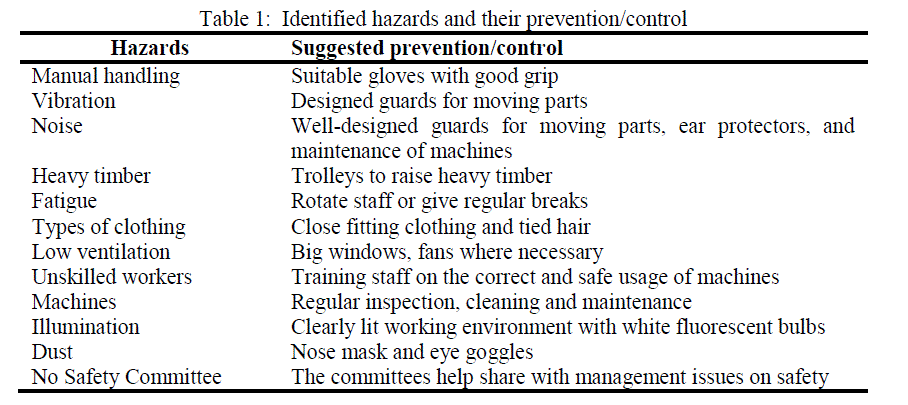 |
| Table 1 shows the results obtained from researchers personal observation. It was observed that little attention was paid to the use of Personal Protective Equipment (PPE). PPE is a must for working [11]. PPE required during work that has the potential for wood dust exposure must be available and used. PPE for wood processing include N95 dust masks, goggles/safety glasses with side shields, gloves, safety footwear, and coveralls [12]. A major risk factor observed was machines used. A lot of the machines were obsolete with most of the safety guards removed or not functioning and dusty. Almost all the factory floor workers pushed, lifted or jacked heavy lumber onto the work table using same posture, which accumulated stress in their lower back causing pains. Administrative controls involving changing how or when workers do their jobs, such as scheduling work and rotating workers to reduce exposures should be practiced [13]. Thinksafe[14] reported that staff can lose their concentration and react more slowly if they’ve been working long hours or for long periods without proper breaks, increasing the likelihood of their making mistakes. Excessive heat and poor air flow can cause loss of concentration. The windows on the factory floor were not big enough, hindering proper air circulation. It was clear from the way some worker went about their duties that they were not skilful. The South Australian Occupational Health, Safety & Welfare Act 1986states that, an employer must ensure that any employee who is to undertake work of a hazardous nature notpreviously performed by the employee receives proper information, instruction and training before he or she commences that work. Some workers were found with loosely fitting shirts with some ladies having their hair loosely hanging on their bodies, but regulations require employers to ensure that workers cover and protect long hair to prevent it from getting caught into running machine parts and also loose dresses should be avoided [13]. Good illumination helps workers notice risks in good time to avoid them. Poor lighting system expose workers to high risk of accidents which could even be fatal. One way in which management can encourage employee participation in any workplace safety program is to create a Safety Committee. The committee helps share with management the responsibilities for implementing and monitoring the company/organization’s safety program. The Committees would organize safety meeting during which safety issues and concerns would be discussed and recent incidents on injuries reviewed and managed. |
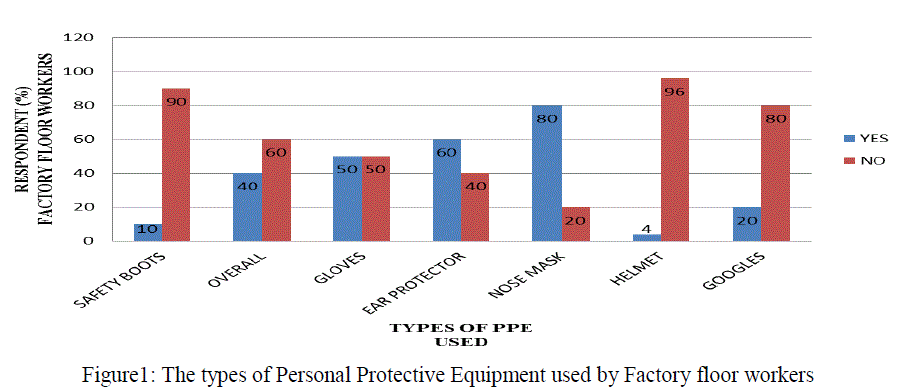 |
| Figure 1 shows that only 10% of workers used safety boots, 40% used overall, 50% used gloves, 60% used ear protectors, 80% used nose mask, 4% used helmet and 20% used goggles. Nose mask, ear protectors and gloves were given to all, but most complained that they were uncomfortable using them. Gloves protect hands from chemicals, rough or sharp parts; boots protect foot from sharp objects such as nails and should be slip resistant to prevent falling [15]. PPE is designed to protect workers from serious injuries; employers should select PPE that properly fit workers so that they will feel comfortable using them[13]. |
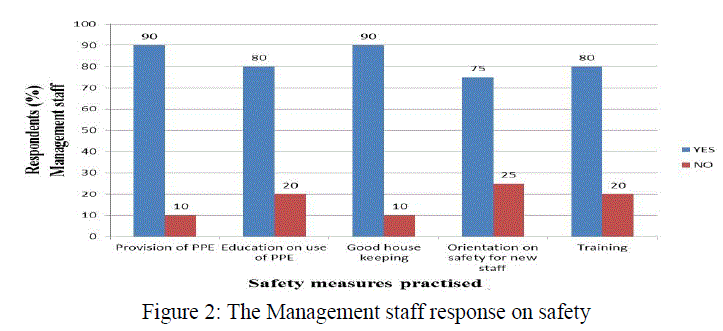 |
| Figure 2 shows that, out of the twenty interviewed, 90% of Management staff ticked yes for provision of PPE, 80% for education on the use of PPE, 90% good housekeeping, 75% orientation on safety for new staff and 80% on training on the job. OSHA’s general PPE requirements mandate that employers conduct hazard assessment [16] of their workplaces to determine what hazards are present that require the use of PPE, provide workers with appropriate PPE, and require them to use and maintain them in sanitary and reliable condition [13]. An employer must provide such information, instruction, training and supervision as are reasonably necessary to ensure that each employee is safe from injury and risks to health [17]. There should be Housekeeping groups to perform daily clean up with appropriate PPE in order to prevent accumulation of wood dust in the vicinity [12]. Developing a culture of safety in the industry supports employees and has positive impact on the company’s bottom line to reduce on-the-job injuries, fatalities and illnesses. |
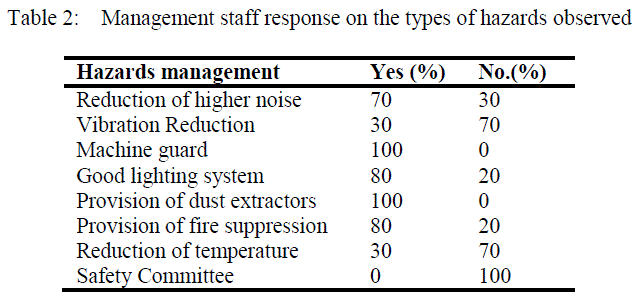 |
| Table 2 shows the results obtained from Management Staff on hazards control. 70% said noise was being managed. There was a lot of noise on the factory floor so workers were provided with ear plugs to reduce their impact. Wearing earplugs or earmuffs can help prevent damage to hearing. Exposure to high noise levels can cause irreversible hearing loss or impairment as well as physical and psychological stress[13]. Only 30% said vibration was reduced since most of the anti-vibration devices were non-functioning. 100% reported of machine guards in place. These are mechanisms put in place to separate workers from moving parts of machines. 80% reported of good lighting system. There were average sized windows and translucent roofs which gave access to natural light. Extra lights were provided by fluorescent tubes. One can decrease the likelihood of injury and harm happening if the areas around machines are clearly lit [14]. All the respondents (100%) reported that dust was being managed, since dust extractors were provided and nose mask were given to all factory floor workers. However, the floor was covered with dust since the extractors were not functioning properly. According to British Columbia Institute of Technology [12], local exhaust ventilation with dust collection should be used to control wood dust dispersion.Majority of the respondents (80%) ticked yes for fire suppression. There were fire extinguishers and emergency exit doors but not for all the departments. This put workers at risk in case of fire outbreak. The factory floor was very hot, however, 30% reported of temperature management since they had either fans or air conditioners in their departments. All the respondents (100%) said there was no Safety Committees. Safety Committees find ways to recognize the efforts of individuals and groups within an organization who make significant contributions to the safety program and motivate them[2]. |
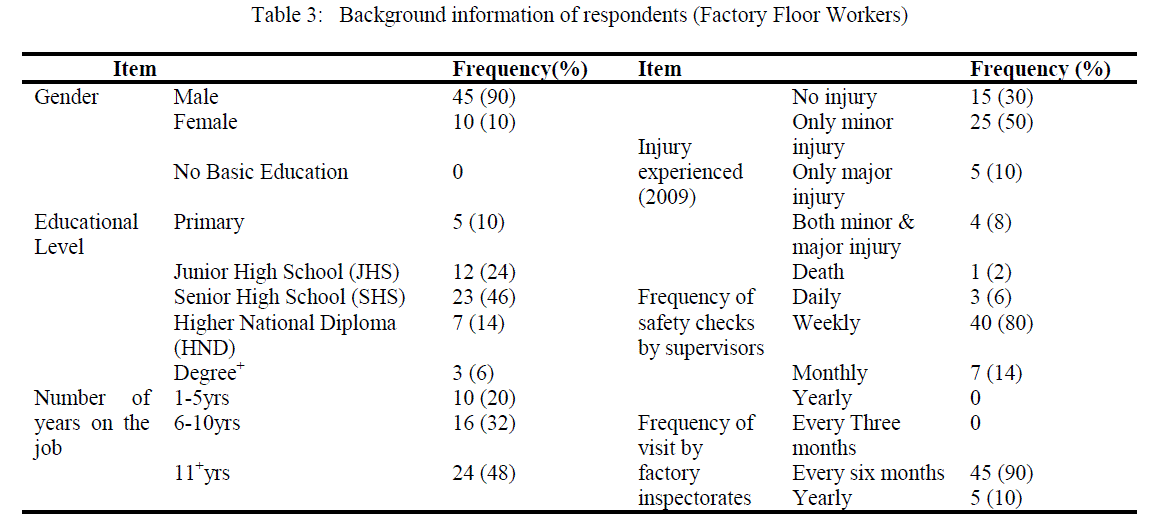 |
| Table 3 shows the demographic distribution of subjects used in this study. Ninety percent (90%) of the production floor members were male, indicating that it is men dominating job; there was nobody without basic education, 10% had Primary education, 24% had JHS education, 46% had SHS education, 14% had HND education and 6% had University Degree. The high level of education of the majority is due to the fact that this company produces to International Standards. Twenty percent had been on the job for 1-5 years, 32% for 6-10 years and 48 % for more than 11years.The longer one stays on a machine, the more experienced one become on its use, meaning there is less risk of injury to such an individual [18]. Within the year 2011, records showed that 30% of the factory floor members experienced no injury, 50% experienced only minor injury, 10% experienced only major injury, 8% experienced both major and minor injuries and 2% experienced death. For the safe and efficient running of machines there should be frequent checks by supervisors, 6% reported that there was daily checks, 80% weekly checks, 14% monthly checks and no report on yearly checks. There should be daily safety inspection of the workshops by instructors or supervisors to ensure that potential hazards are identified promptly and corrected immediately [12]. According to Ghana Labour Act[19], an inspector has power to enter freely and without notice at any hour of the day or night to inspect any workplace during working hours, which the inspector has reason to believe is subject to inspection. Any person who willfully obstructs a labour inspector in the performance of his or her functions under this Act commits an offence. However, it was reported that, there was no inspection within three month period, 90% reported of inspection every six months and 10% once in a year. Thus it may take a longer period for an irregularity to be identified, hence causing accidents and even death, draining the resources of the entrepreneur. However, entrepreneurship is a major source of economic growth and job creation, through the development of new businesses and how to make the businesses successful [20] |
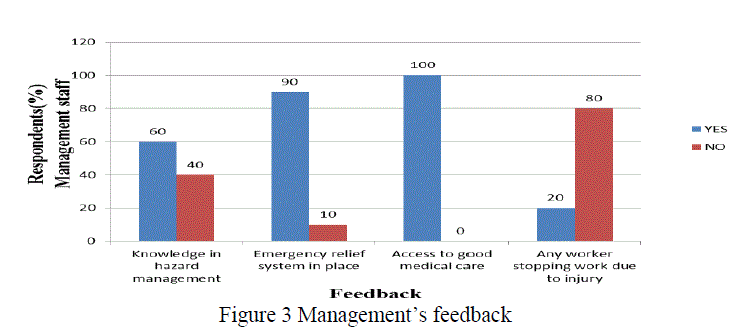 |
| Figure 3 showed that 60% of Management Staff had knowledge in hazards management, 90% said emergency relief systems were in place, 20% reported that some workers stopped work due to injuries, however all said they had good medical care in the Factory’s Clinic. Safety committee should be formed to educate managers, supervisors and employees through awareness and training activities that they are primarily responsible for the prevention of workplace accidents. There should be assessment and controlling of hazards by communicating with employees regarding safety committee activities. There should also be safety training and awareness on safety-related topics. This should be evaluated from time to time so that safety rules, policies and procedures could be successfully developed. This will reduce incidence of workplace accidents. |
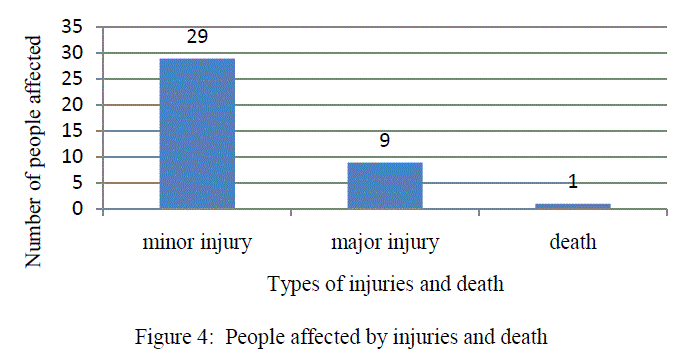 |
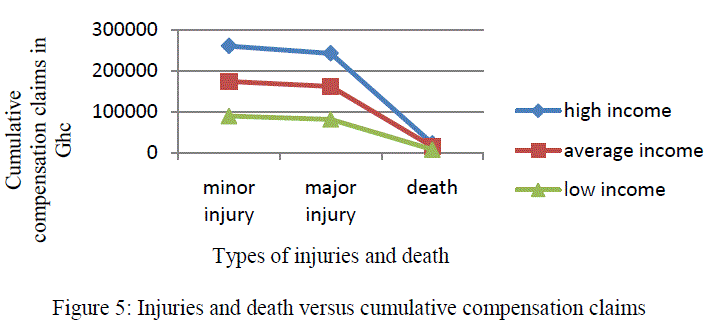 |
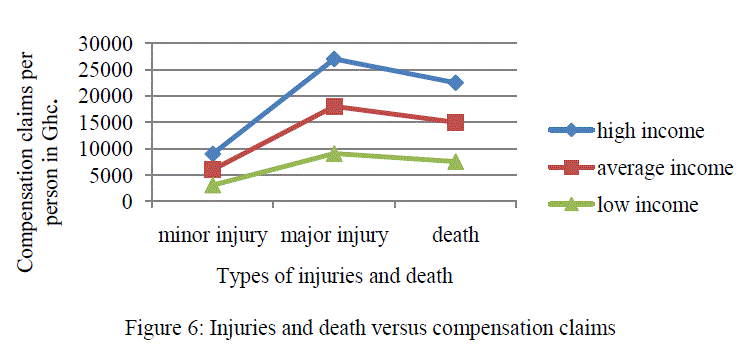 |
| Figures 4, 5 and 6 gave detailed account of the number of people who suffered from minor injuries, major injuries and death in 2011 with their respective cumulative compensation as well as individual compensation claims in Ghana cedis. In all cases of injuries, the employer shall pay all medical expenses, but no compensation shall be payable under this law in respect of any incapacity or death resulting from a deliberate self-injury or under the influence of intoxicating liquor or drugs at the time of the accident.In the case of permanent total incapacity (not resulting to death), the amount of compensation payable is equivalent to ninety-six months’ earnings. Partial incapacity is a percentage of the total incapacity based on the extent of injury. In case of death, the employer bears the burial cost as well as paying a sum equivalent to sixty months earnings to the dependants of the workman [4]. Figure 5 showed that, compensation is based on how much income one takes. The cumulative compensation paid for a high income earner of minor injury was Ghc 260,884.00 that of major injury was Ghc 242,892.00 and that of death Ghc 22,490.00. For average income earners, cumulative compensation claim of Ghc 174,290.00.00 was for minor injuries, Ghc 162,270.00.00 for major injuries and Ghc 15,025.00 for death. For low income low income earners, cumulative compensation claim of Ghc 87,696.00 was for minor injuries, Ghc 81,648.00 for major injuries and Ghc 7,560.00 for death. This was because the number of people who suffered from minor injuries outnumbered those of major injuries and death in decreasing order. |
| Figure 6 showed that, within a given category of salary earners, major injury compensation was the highest, followed by death and then minor injury. For a high income earner, a compensation claim of Ghc 8,996.00 was for minor injury, Ghc 26,988.00 for major injury and Ghc 22,490.00 for death. For an average income earner, a compensation claim of Ghc 6,010.00 was for minor injury, Ghc 18,030.00 for major injuries and Ghc 15,025.00 for death. For a low income earner, a compensation claim of Ghc 3,024.00 was for minor injury, Ghc 9,072.00 for major injury and Ghc 7,560.00 for death. The Ghana cedi: Dollar rate was 1.60Ghc to 1USD. |
 |
| This amount is much lower than how much the employer would have paid in terms of compensation for even the low income earner with a minor injury. An entrepreneur is anyone who assumes the risk of a business or an enterprise and in this case the entrepreneur should take a calculated risk of buying and enforcing the use of PPE, to save lives and productive hours, which is much cheaper than compensation claims. It is hoped that by improving occupational safety, workers’ compensation rates for all industries will be reduced. |
IV. CONCLUSION |
| Wood workers are exposed to many hazards in their working environment and as such there have been several studies conducted on occupational health and safety in the wood processing industries in the Kumasi metropolis. Almost all the reports indicate that wood workers are exposed to various types and degrees of occupational hazards ranging from cancerous to non-cancerous conditions, bacterial, viral and chemical infections to physical injury and accidents. Yet, safety in the wood processing industry is often taken for granted by workers and employers. Safety measures of interest include safety monitoring, plant inspection, and use of safety gadgets. Workers must be provided with healthy occupational environment by making and implementing all safety polices and interventions.In Entrepreneurship, success depends on people’s willingness to become entrepreneurs. If workers are provided with PPE’s and constantly trained on their proper use and safety practices, workers become confident so fatalities and serious injuries in the wood industry will be eliminated. Claims in terms of compensation will reduce and the entrepreneur will make substantial wealth.This will reduce social and financial cost that is unsafe to the entrepreneur. |
V. RECOMMENDATIONS |
| It is essential for policy makers to implement binding legislations that would safeguard the safety and health of workers, while mandating factory management to show commitment towards workers’ health and safety to ensure a safe working environment in the wood manufacturing industry. |
| • There should be orientation on safety for all new staff and others resuming from leave. |
| • There should be regular training on the use of PPE and management should ensure that they are effectively used. |
| • There should be good housekeeping. |
| • The Factory Inspectorates should visit the place regularly. |
| • The Entrepreneurs should register with insurance companies who will take care of the compensations so that profit margins will not be seriously affected. |
| • There should be Safety Committees who would meet regularly to deliberate on safety issues concerning the industries |
References |
|